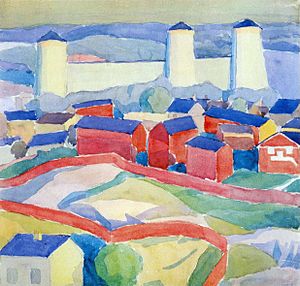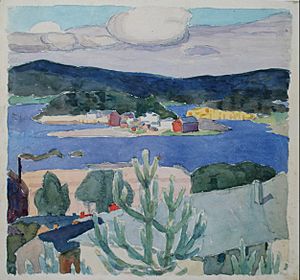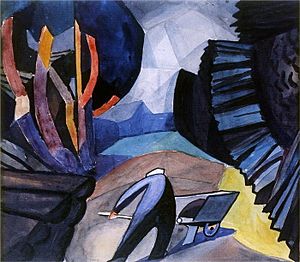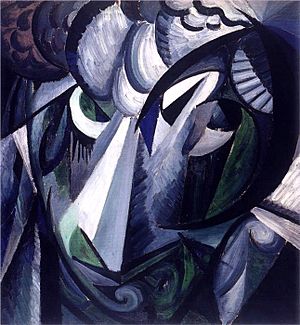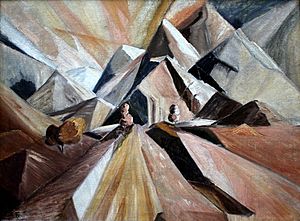Alexander Bogomazov facts for kids
Quick facts for kids
Oleksandr Bohomazov
Олександр Богомазов
|
|
|---|---|
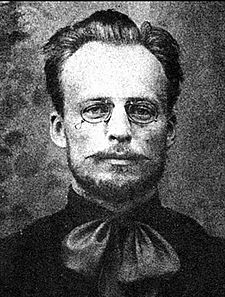 |
|
| Born | March 27, 1880 Yampil, Russian Empire (now Ukraine)
|
| Died | June 3, 1930 (age 50) |
| Known for | Painting, Drawing |
| Movement | Cubism, Futurism, Spectralism |
| Spouse(s) | Wanda Monastyrska (m.1913-1930) |
Oleksandr Bohomazov (Ukrainian: Олександр Костянтинович Богомазов; born March 27, 1880 – died June 3, 1930) was a famous Ukrainian painter. He was a key artist in the Ukrainian avant-garde movement, known for his unique art styles like Cubo-Futurism and Spectralism. In 1914, Oleksandr wrote an important book called The Art of Painting and the Elements. In this book, he explored how objects, artists, paintings, and viewers connect. This helped create the ideas behind modern art.
Contents
Early Life and Art School
Oleksandr Bohomazov was born in Yampil, Ukraine. He was the second child of Kostiantyn and Anisia Bohomazov. His father was an accountant who later became a merchant. Oleksandr's mother left the family when he was young.
He showed an early interest in painting while in school. However, his father thought his art was too rough. He wanted Oleksandr to study agronomy at the Kherson Agricultural School. Oleksandr studied there from 1896 to 1902. But his love for art was stronger. With his uncle's help, he convinced his father to let him move to Kyiv. In 1902, he joined the Kyiv Art School.
At the Kyiv Art School, Bohomazov learned from famous teachers like Oleksandr Murashko. Other future avant-garde artists, such as Oleksandra Ekster and Oleksandr Arkhypenko, studied with him. In 1905, he was asked to leave the school. This was because he took part in student protests and strikes.
After that, in 1906, he studied in Serhiy Sviatoslavskyi's studio in Kyiv. In the summer of 1907, he went to Crimea with fellow students. They rented a small house and spent their days sketching. Bohomazov then went to Moscow to study more art. He returned to Kyiv in 1908. There, he joined the city's first Modernist art show called Zveno ('The Link').
Exploring Art Styles
The Finnish Cycle: Nature's Beauty
In June 1911, Bohomazov worked for a newspaper called Kyivska Dumka. They sent him on a trip to Karelia, which is now part of Finland and Russia. His job was to create paintings and prints of Finnish landscapes. These would be used in a special newspaper section.
For about six weeks, Bohomazov traveled through places like Imatra and Savonlinna. This trip led to many paintings, watercolors, and ink drawings. We don't know the exact number, but these works are now in different collections and museums.
In Imatra, he painted The Tower and A Castle in Finland. Both show the beautiful Grand Hotel de Cascade. This hotel looked like a castle and was built in the Art Nouveau style. It reminded people of the Olavinlinna Castle across Lake Saimaa.
Bohomazov also loved the famous rapids of Imatrankoski. He enjoyed the calm Finnish landscapes, which matched his feelings. He wrote to his future wife, Wanda, about painting The Sea Waves. He also created a series of watercolors showing the rapids. These included Stream and Rocks. Istra River-1 and Wave. Istra River-2. In Lappeenranta, he painted two watercolors: Finland and Finnish Landscape.
His trip also inspired romantic drawings and watercolors of places near Vyborg. These included Monrepos Park and the three-towered Olavinlinna Castle. Lake Saimaa also inspired him. He even dedicated a drawing to his future wife, calling the lake's beauty "fairy-tale."
Cubo-Futurism: Art in Motion
The years 1913-1914 were a time of intense artistic exploration for Bohomazov. In September 1914, he finished his important book, "Painting and Its Elements." This book summarized his thoughts on art and how it's made. Even before he wrote it, his art from 1913 showed his interest in new art styles. He was especially drawn to Futurism, which showed movement and energy.
In his works from this time, he used techniques to make things feel like they were moving. For example, he often used many straight lines that came together. These lines created ray-like or fan-like shapes that showed powerful movement. He also made straight lines long and thin, like needles, as seen in his painting "Train."
Bohomazov also used bright, strong colors next to empty spaces. This made his art more interesting. He often placed shapes diagonally in his paintings. This technique is clear in "Train. Boyarka." It created a feeling of strong tension and movement. In 1913, he focused a lot on straight lines. These lines created energetic bursts in his art.
The year 1914 was a turning point for Bohomazov. He not only wrote down his ideas about "New Age" art but also became a truly unique artist. He started to use all his techniques on purpose to show nature and its feelings. He actively used the new ideas from his book, "Painting and Its Elements."
In his 1914 works, he combined simple flat shapes into more complex 3D objects. He realized that only flat shapes and straight lines limited how much movement he could show. So, he added new elements, like curved lines.
He also used a technique called "mosaic toning." This meant strengthening parts of the forms. This gave them a stronger sense of movement. He also varied the color and texture within his paintings. This showed his idea of "interval" in art.
In 1914, he helped organize an exhibition called Kiltse ("The Ring") in Kyiv. Other artists like Oleksandra Ekster also took part. In 1915, Bohomazov moved to the Caucasus. There, he worked as a teacher and continued to paint.
In 1927, he helped start the Association of the Revolutionary Masters of Ukraine (ARMU). He worked with other artists like David Burliuk and Vadym Meller. Oleksandr Bohomazov died on June 3, 1930, in Kyiv.
His Ideas and Teaching
Bohomazov's ideas about art are very important. In 1914, while living in Boyarka, near Kyiv, he wrote his book "Painting and Its Elements." In it, he explained how art forms develop. He said that art starts from the movement of a single dot. He saw painting as a changing system with its own rules.
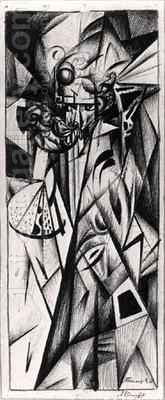
In his book, Bohomazov was the first to see rhythm as more than just a number. He saw it as a quality, which was a big discovery. He explained how an artist can turn the rhythm of everyday life into a painting. He showed how a calm painting can become full of energetic lines and shapes. This is like how our minds can become excited by the rhythm of things we see. Rhythm, he said, can make us feel sad or happy.
Many of Bohomazov's ideas came before those of other famous artists. For example, he talked about a black square on a white background being the "most perfect form." This was a year before Malevych created his famous Black Square painting. Bohomazov greatly helped shape how art forms were seen in the 20th century. He showed that forms could be important on their own.
The French art expert Andréi Nakov called Bohomazov's book "prophetic." Sadly, because of the First World War and later conflicts, the book was not published for a long time. It was finally published in 1996 in Kyiv.
Teaching art was important for Bohomazov. It allowed him to share his new ideas and earn money. This was especially true during the difficult times in Ukraine in the early 1900s. His first teaching job was in the Caucasus in 1915. He taught graphic art in a high school in Goris (now in Armenia) until 1917. When he returned to Ukraine, he taught in several schools.
From 1919, he also taught at the First State Studio for Paintings in Kyiv. He was also the head of art education for the Ukrainian government. He helped create the Ukrainian Agitprop Movement, designing art for it. From 1922 until his death in 1930, he was a professor at the Kyiv Arts Institute. He taught alongside other important artists. His teaching style was unique. He explained how art changed over time and how it was connected to history and society.
Global Recognition
After Bohomazov died, his name was largely forgotten in the Soviet Union. His works were shown only once in 1966 in Kyiv. Until the early 1970s, art experts in Ukraine and the West mostly ignored his work. In late 1973, a French-Bulgarian art researcher, Andréi Nakov, was able to see Bohomazov's studio. The artist's widow had kept his works. Nakov was very impressed by Bohomazov's Futurist art. He wrote about it and published the first short studies on Bohomazov in Western Europe.
His works were first shown outside Kyiv in 1973. Several of his paintings were part of the Tatlin’s Dream exhibition in London. After the fall of the Berlin Wall and Ukraine's independence, more of his work could be shown. In 1991, his paintings were shown at the Musée d’Art Moderne in Toulouse, France. The museum director, Alain Mousseigne, was very excited about Bohomazov's art. He worked hard to show his works in museums.
Encouraged by this success, Ukrainian officials also organized the same exhibition in Kyiv. Since then, more books about Bohomazov have been published in Ukraine. His works are now in public collections in Ukraine and the West. These include the MoMA and Guggenheim Museum in New York. They are also in the Art Institute Chicago, Museum Ludwig in Cologne, and the NAMU in Kyiv.
In 2022, Bohomazov's works were part of an exhibition called 'In the Eye of the Storm: Modernism in Ukraine 1900-1930'. This show was supported by the Museo Nacional Thyssen-Bornemisza in Madrid. Many works were loaned from Ukrainian museums. Bohomazov's art, along with other Ukrainian avant-garde artists, was carefully moved during the Russian Invasion. After Madrid, the exhibition will travel to Museum Ludwig in Cologne, Germany, in 2023. Bohomazov's 'Landscape' is even on the cover of the art book for the exhibition.
Representative Works
-
'Cityscape', 1913-14, Museum Ludwig, Cologne
-
"Fire in Kiev." 1916. Paper, charcoal. 27х32 sm. National Art Museum of Ukraine (NAMU), Kyiv
See also
 In Spanish: Alexander Bogomazov para niños
In Spanish: Alexander Bogomazov para niños


